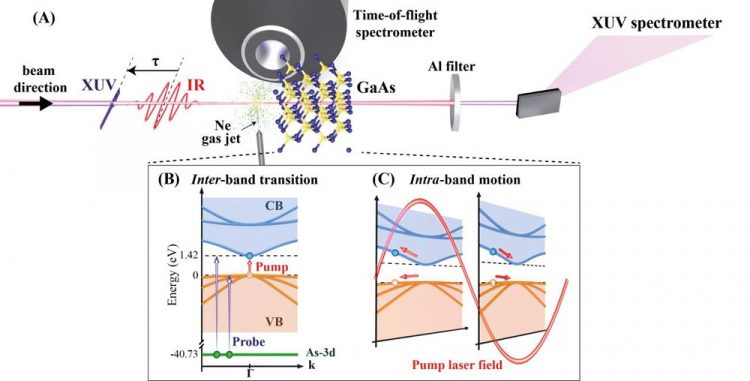A milestone in petahertz electronics

(A) An intense few-cycle infrared (IR) laser pulse is combined with a single attosecond probe pulse with a spectrum in the extreme-ultraviolet (XUV) energy regime. (B) & (C) Illustration of IR-induced inter- and intra-band transitions. Credit: Adapted from Schlaepfer et al., Nature Physics doi:10.1038/s41567-018-0069-0 (2018).
Gallium arsenide is a technologically important narrow-band-gap semiconductor, in which the excitation of electrons from the valence into the conduction band produces charge carriers that can transport electrical current through electronics components.
In addition to this so-called inter-band transition, carriers can also be accelerated within the individual bands as the electrons interact with the laser light. This is due to the strong electric field associated with the laser light, leading to intra-band motion.
Which of the two mechanisms dominates the response to a short intense laser pulse, and how their interplay effects the carrier injection into the conduction band, is far from obvious.
Fabian Schlaepfer and his colleagues in the group of Ursula Keller in the Department of Physics have now studied these processes for the first time at the attosecond timescale, combining transient absorption spectroscopy with state-of-the-art first-principles calculations.
As they report in a paper that appears today online in Nature Physics, they found that intra-band motion has indeed an important role, as it significantly enhances the number of electrons that get excited into the conduction band.
This finding was unexpected because intra-band motion alone is unable to produce charge carriers in the conduction band.
These results therefore represent an important step forward in understanding the light-induced electron dynamics in a semiconductor on the attosecond timescale, which will be of practical relevance for future electronics and optoelectronics devices, whose dimensions become ever smaller, and the electric fields involved ever stronger and the dynamics ever faster.
Media Contact
All latest news from the category: Physics and Astronomy
This area deals with the fundamental laws and building blocks of nature and how they interact, the properties and the behavior of matter, and research into space and time and their structures.
innovations-report provides in-depth reports and articles on subjects such as astrophysics, laser technologies, nuclear, quantum, particle and solid-state physics, nanotechnologies, planetary research and findings (Mars, Venus) and developments related to the Hubble Telescope.
Newest articles

Superradiant atoms could push the boundaries of how precisely time can be measured
Superradiant atoms can help us measure time more precisely than ever. In a new study, researchers from the University of Copenhagen present a new method for measuring the time interval,…

Ion thermoelectric conversion devices for near room temperature
The electrode sheet of the thermoelectric device consists of ionic hydrogel, which is sandwiched between the electrodes to form, and the Prussian blue on the electrode undergoes a redox reaction…

Zap Energy achieves 37-million-degree temperatures in a compact device
New publication reports record electron temperatures for a small-scale, sheared-flow-stabilized Z-pinch fusion device. In the nine decades since humans first produced fusion reactions, only a few fusion technologies have demonstrated…





















